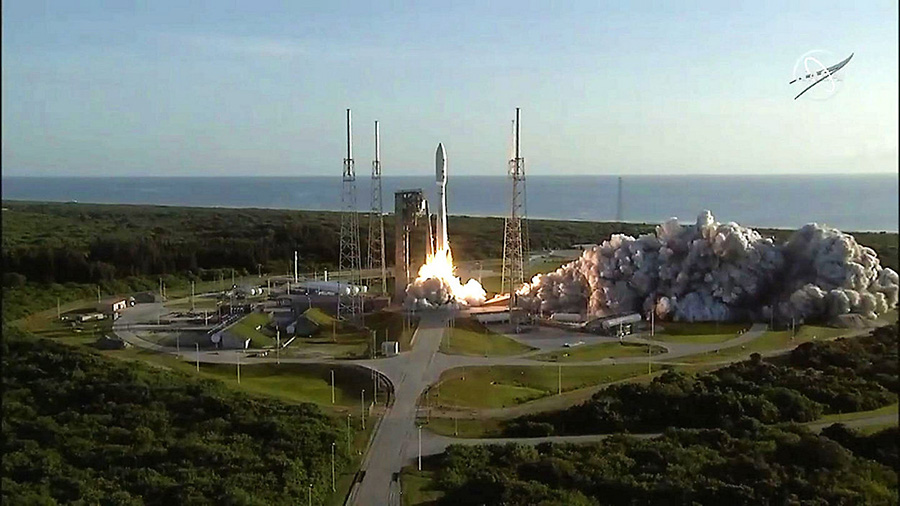
Keep up to date with all things space at the 2020 Space Calendar at Space.com. Updated on a regular basis, the Space Calendar lets you know about meteor shower, planetary conjunctions, rocket launches and more. Some dates change, like rocket launches, so the calendar is updated accordingly.
The calendar covers events through the end of December. Here are the events currently listed (July 30) through the end of August. Check the Space.com calendar for changes and updates.
July 30: NASA’s Mars 2020 rover launches to the Red Planet! It will lift off on a United Launch Alliance Atlas V rocket from Cape Canaveral Air Force Station in Florida, during a 2-hour launch window that opens at 7:50 a.m. EDT (1150 GMT). Watch it live.
July 31: A SpaceX Falcon 9 rocket is expected to launch the ninth batch of approximately 60 operational satellites for the company’s Starlink broadband network, along with two Earth-observing satellites for BlackSky Global, in a mission designated Starlink 9. It will lift off from Space Launch Complex 40 at Cape Canaveral Air Force Station in Florida, at 3:45 a.m. EDT (0745 GMT). Watch it live.
July 31: Arianespace will use an Ariane 5 ECA rocket to launch the Galaxy 30 communications satellite, the second Mission Extension Vehicle satellite servicing spacecraft and the BSat 4b broadcasting payload. The mission, designated VA253, will lift off from the Guiana Space Center near Kourou, French Guiana, at 5:30-6:16 p.m. EDT (2130-2216 GMT). Watch it live.
AugustÂ
Aug. 1-2: SpaceX’s Crew Dragon Demo-2 mission will return to Earth from the International Space Station with NASA astronauts Bob Behnken and Doug Hurley. The Crew Dragon spacecraft will undock from the space station Saturday (Aug. 1) at 7:34 p.m. EDT (2334 GMT), and it will splash down in the Atlantic Ocean on Sunday at approximately 2:42 p.m. EDT (1842 GMT). Watch it live.
Aug. 1: The nearly-full moon will be in conjunction with Jupiter at 7:32 p.m. EDT (2332 GMT). The following morning (Aug. 2), it will be in conjunction with Saturn at 9:10 a.m. EDT (1310 GMT). Look for the trio in the evening sky.Â
Aug. 3: The full moon of August, known as the “Sturgeon Moon,” occurs at 11:59 a.m. EDT (1559 GMT).Â
Aug. 6: A Russian Soyuz rocket will launch a Glonass K navigation satellite from the Plesetsk Cosmodrome in Russia.Â
Aug. 9: The waning, gibbous moon will make a close approach to the Red Planet in the early morning sky. It will be in conjunction with Mars at 4 a.m. EDT (0800 GMT).Â
Aug. 11-12: The Perseid meteor shower peaks.Â
Aug. 15: The waning crescent moon will be in conjunction with Venus, the “morning star,” at 9:01 a.m. EDT (1301 GMT). Look for the pair above the eastern horizon before dawn.Â
Aug. 17: An Arianespace Vega rocket will launch on the Small Spacecraft Mission Service (SSMS) proof-of-concept mission carrying 42 microsatellites, nanosatellites and cubesats. The rideshare mission will lift off from the Guiana Space Center near Kourou, French Guiana, at 9:51 p.m. EDT (0151 GMT on Aug. 18).
Aug. 18: Black Moon: The third new moon in a season with four new moons is known as a “black moon.” (A black moon can also be the second new moon in a single calendar month.)
Aug. 26: A United Launch Alliance Delta IV Heavy rocket will launch a classified spy satellite for the U.S. National Reconnaissance Office. The mission, titled NROL-44, will lift off from Cape Canaveral Air Force Station in Florida.
Aug. 28/29: The waxing, gibbous moon will be in conjunction with Jupiter at 9:35 p.m. EDT (0235 GMT on Aug. 29). The following day, it will be in conjunction with Saturn at 12:32 p.m. EDT (1632 GMT). Look for the trio in the evening sky.
Links at Space.com
